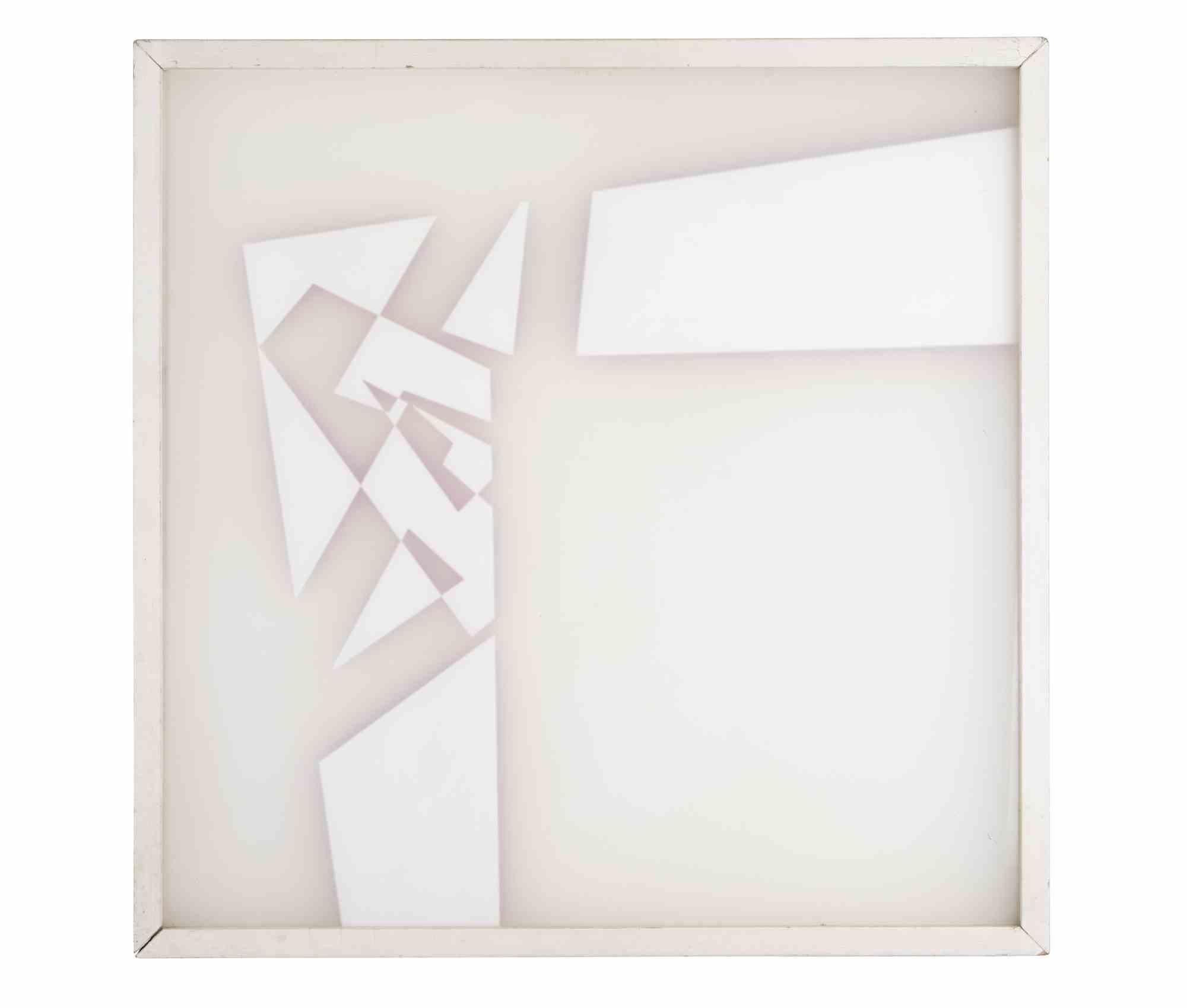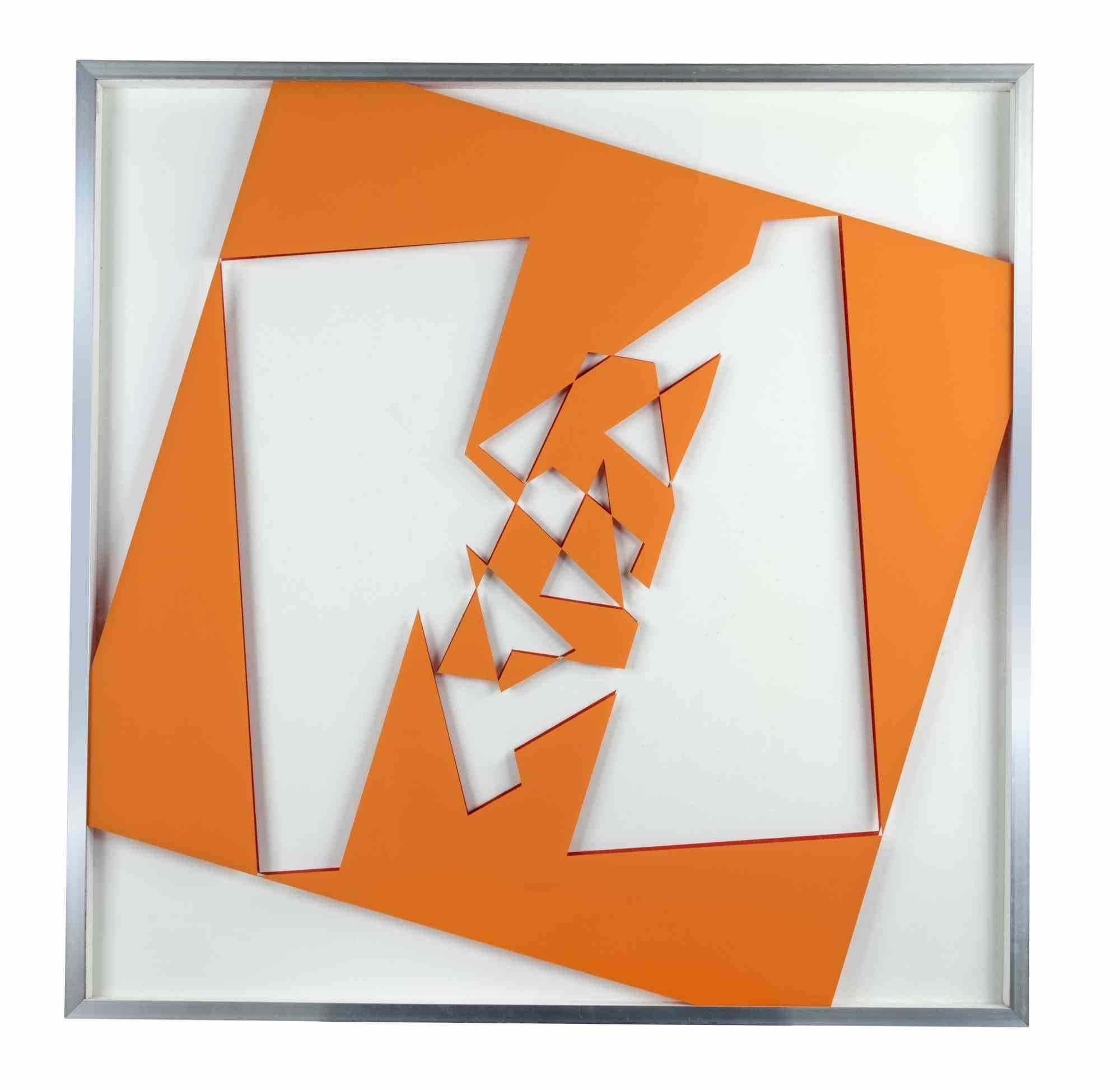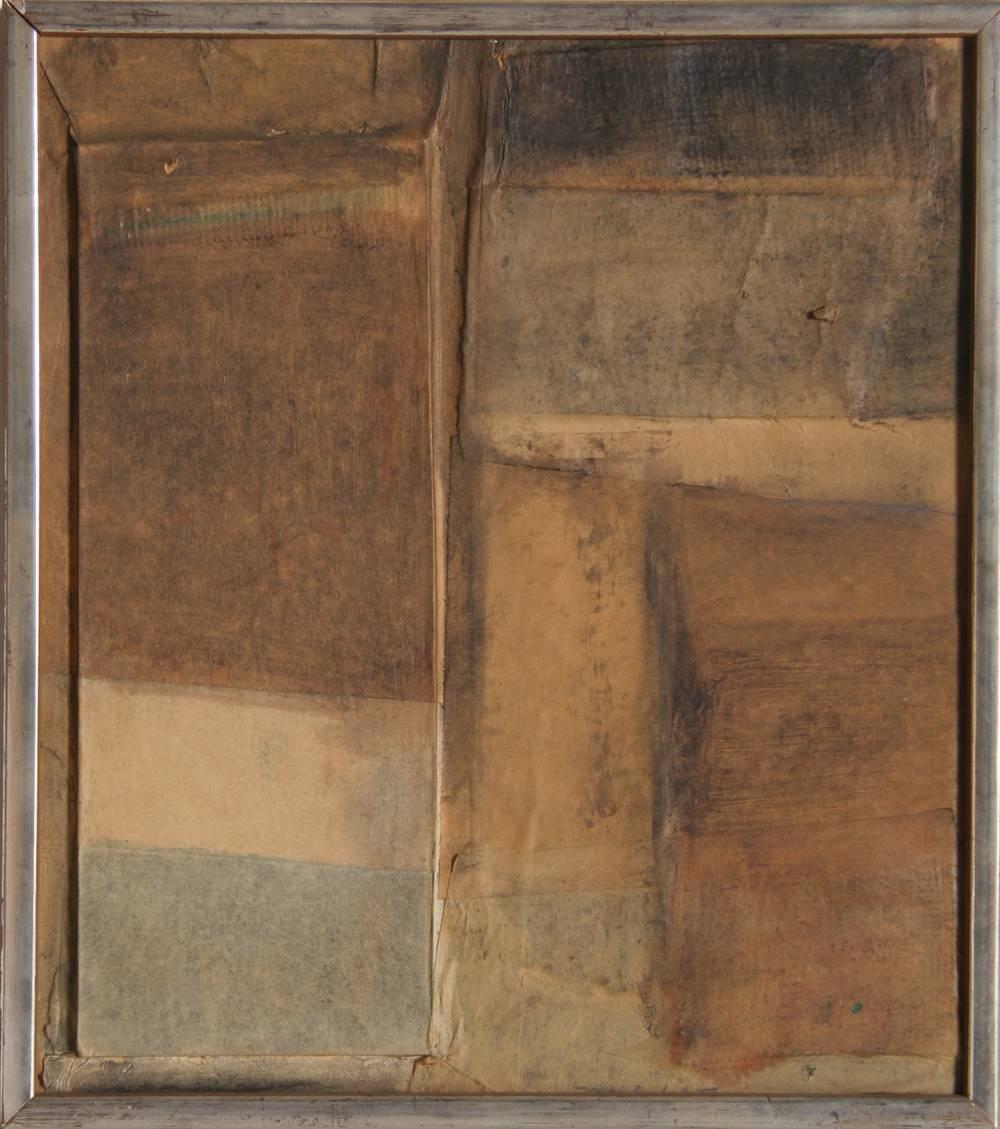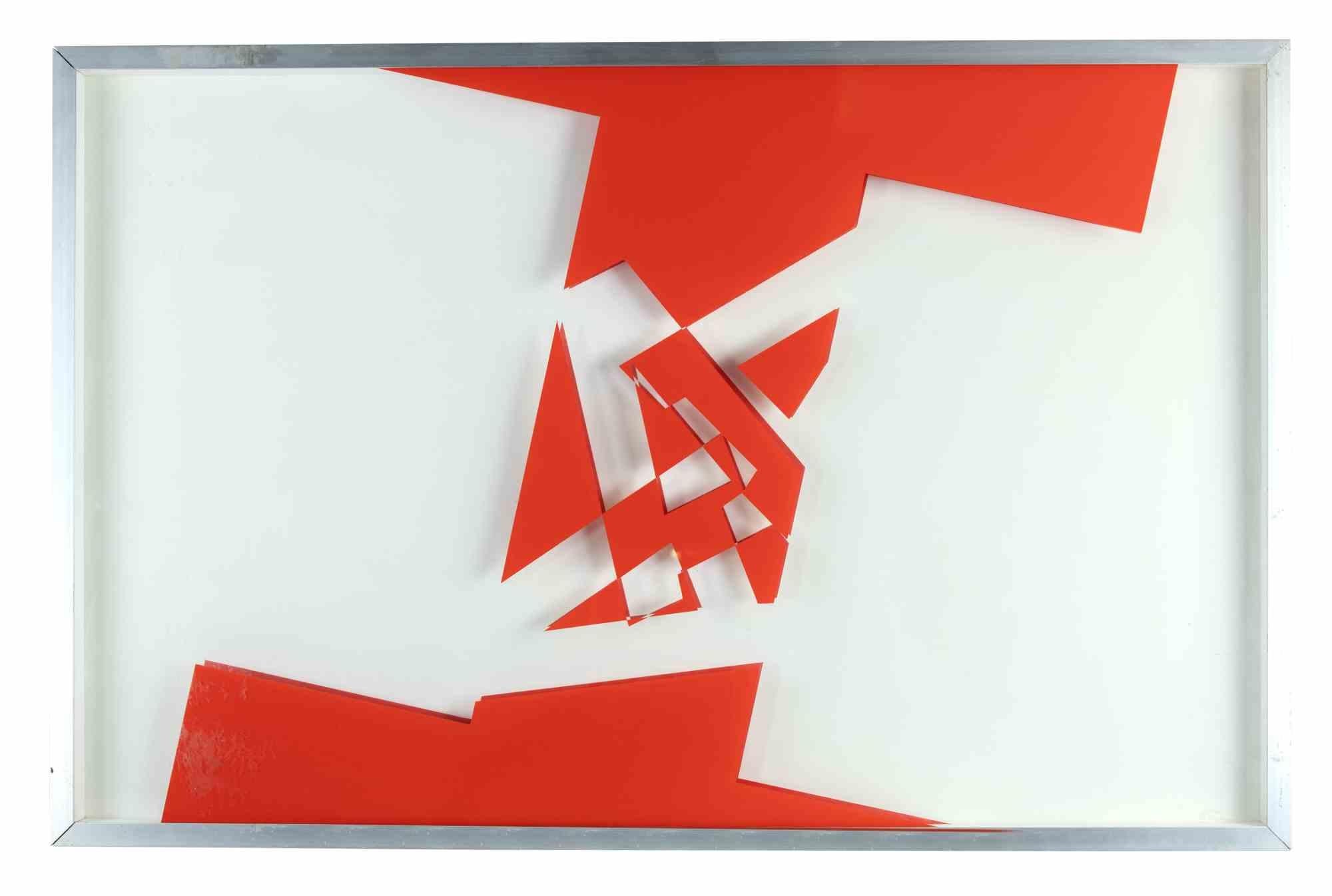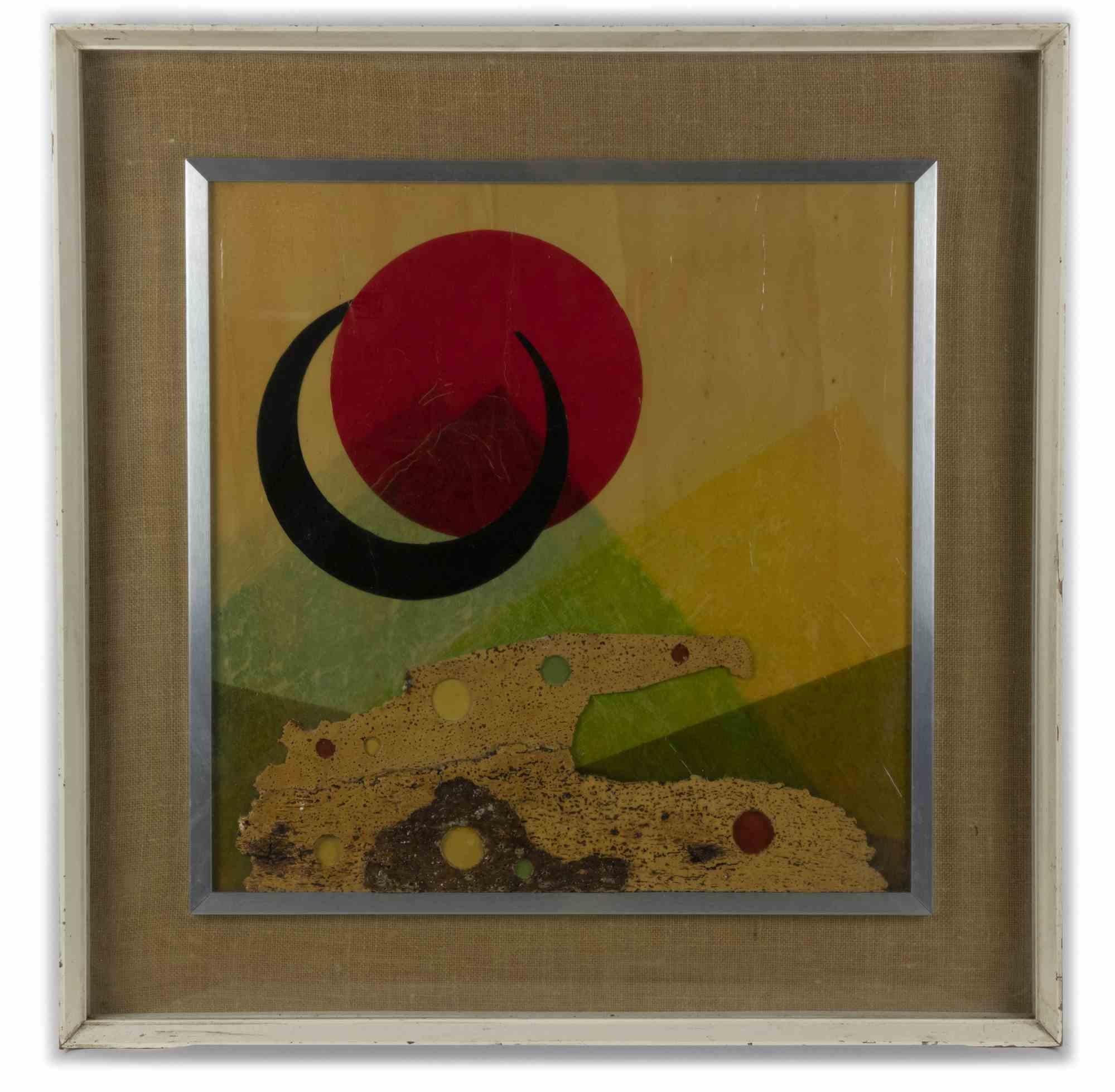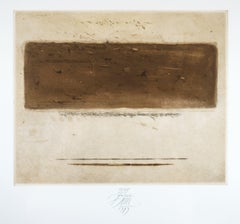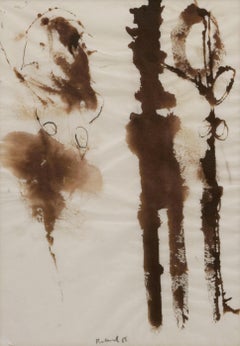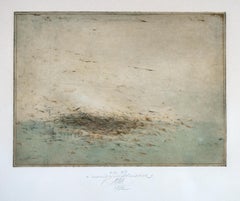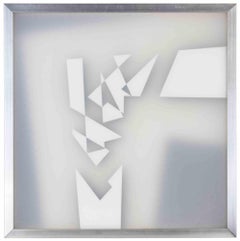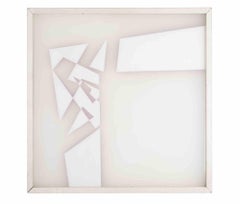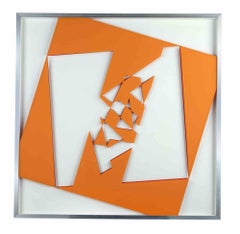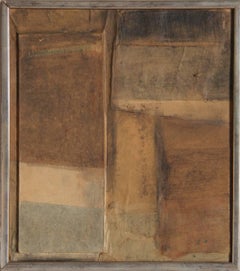Items Similar to Collage with metal application / - Rhythm and Reflection -
Want more images or videos?
Request additional images or videos from the seller
1 of 6
Hermann GoepfertCollage with metal application / - Rhythm and Reflection -1965
1965
$614.41
$768.0120% Off
£465.90
£582.3720% Off
€520
€65020% Off
CA$864.89
CA$1,081.1120% Off
A$944.92
A$1,181.1520% Off
CHF 495.24
CHF 619.0420% Off
MX$11,282.63
MX$14,103.2920% Off
NOK 6,267.25
NOK 7,834.0620% Off
SEK 5,844.08
SEK 7,305.1020% Off
DKK 3,961.24
DKK 4,951.5520% Off
About the Item
Hermann Goepfert (1926 Bad Nauheim - 1982 Antwerp), Collage with metal application, 1965. Contribution no. 14 from the anthology 'La lune en rodage II' published by Editions Panderma Carl Laszlo. Sheet dimensions 13.5 cm (height) x 25 cm (length), frame 29 cm (height) x 35.5 cm (length). Signed "Goepfert." lower right.
- The originally folded collage with brown shadows of the adhesive strips, one strip detached in the right margin. The framing by F. G. Conzen somewhat rubbed.
- Rhythm and Reflection -
Four brown stripes are visible on the left side of the two-part sheet. Two of them border the image at the top and bottom, while the other two shorter stripes run parallel to them, slightly offset downward. This displacement creates a tension which, in the sequence of the stripes, is also rhythmic in nature.
On the other side of the sheet, there is an aluminum bar, also horizontally oriented, which, in relation to the opposite side, is positioned exactly in the middle between the shorter brown stripes, creating a tension between the surfaces of the stripes and the spatial body of the metal. In addition, the aluminum object has an undulating movement that is related to the rhythm of the stripes, creating a melodic effect. And the reflections of the metal form another kinetic moment in the minimalist work, which at first glance appears motionless.
With his collage, Gopfert succeeds in programmatically presenting his concept of art within the artist anthology.
About the artist
After studying at the Städelschule in Frankfurt from 1951 to 1958, Hermann Goepfert became the most important representative of the ZERO movement in Frankfurt. The name of the ZERO group, which was supported by Heinz Mack, Otto Piene, and Günther Uecker, refers both to the "zero hour" that heralds new reconstruction and to the countdown of a rocket launch, and programmatically stands for the dawn of a new era that also heralds a new era of art.
Beginning in 1960, Goepfert formulated the new artistic position with his white paintings and participated in renowned progressive exhibitions such as the groundbreaking NUL show at the Stedelijk Museum in Amsterdam and Documenta III in Kassel. He also participated in the ZERO exhibitions with the aluminum reflectors he created in 1962.
The premise that "light is form" is fundamental to his artistic work, and he also translated light into sound with his optophonies.
In 1965, together with the architect Johannes Peter Hölzinger, Goepfert founded the "Planungsgemeinschaft für neue Formen der Umwelt", thus combining art and architecture. In 1971 Goepfert moved to Antwerp, where he died in 1982.
In 1987 the Frankfurter Kunstverein organized the retrospective 'Goepfert and ZERO - ZERO and Goepfert'.
Exhibitions (selection)
1962 NUL im Stedelijk Museum, Amsterdam
1964 documenta III, Kassel
1967 Palais des Beaux Arts, Brüssel
1979 ZERO, Bildvorstellungen einer europäischen Avantgarde 1958-1964, Kunsthaus Zürich
1987 Retrospektive Goepfert und ZERO - ZERO und Goepfert, Kunstverein Frankfurt am Main
2005 L’Œil moteur- Art optique et cinétique, 1950-1975, Musée d'Art Moderne et Contemporain (MAMCS), Strasbourg
2008 ZERO lebt – europäische Avantgarde der 50er und 60er Jahre, Kunsthalle Weishaupt
2011 Hermann Goepfert. Licht als Vision - Bilder und Werke aus den 1950er bis 1970er Jahren, Galerie Dierking, Köln
2015 Group show ZERO – The International Art Movement of the 50ies and 60ies, Martin-Gropius Bau, Berlin
Group show ZERO – Let Us Explore the Stars, Stedelijk Museum, Amsterdam
ZERO: Countdown to Tomorrow, 1950s–60s, Guggenheim Museum, New York
2016 Kunst nach 1945 - 1968, Zentrum für Kunst und Medien, Karlsruhe
2017 Le socle du monde Biennale, Herning Museum of Contemporary Art, Dänemark
Hermann Goepfert - Malerisch, Dierking, Zürich
2021 Gruppenausstellung Sign 0’ the Times - Lucio Fontana, Hermann Goepfert, Jef Verheyen, Dierking, Zürich.
Selected bibliography
Beate Kemfert (Hrsg.): Hermann Goepfert, Ostfildern 2015.
GERMAN VERSION
Hermann Goepfert (1926 Bad Nauheim - 1982 Antwerpen), Collage mit Metallapplikation, 1965. Beitrag Nr. 14 aus der in der Editions Panderma Carl Laszlo erschienen Anthologie ‚La lune en rodage II‘. Blattmaße 13,5 cm (Höhe) x 25 cm (Länge), Rahmen 29 cm (Höhe) x 35,5 cm (Länge). Unten rechts mit „Goepfert.“ signiert.
- Die ursprünglich gefaltete Collage mit braunem Schatten der Klebestreifen, ein Streifen im rechten Randbereich abgelöst. Die von F. G. Conzen vorgenommene Rahmung etwas berieben.
- Rhythmik und Reflexion -
Auf dem zweigeteilten Blatt sind auf der linken Seite vier braune Streifen zu sehen. Zwei begrenzen das Bildfeld nach oben und unten hin, während die anderen beiden kürzeren Streifen parallel dazu etwas nach unten versetzt angebracht sind. Durch diese Verschiebung entsteht eine Spannung, die – in der Abfolge der Streifen – zugleich rhythmischer Natur ist.
Auf der anderen Seite des Blattes ist ein ebenfalls horizontal ausgerichteter Aluminiumsteg platziert, der - auf die gegenüberliegende Seite bezogen - genau mittig zwischen den kürzeren braunen Streifen situiert ist, so dass eine Spannung zwischen den Flächenkörpern der Streifen und dem Raumkörper des Metalls entsteht. Zudem weist das Aluminiumobjekt eine Wellenbewegung auf, die sich auf den Rhythmus der Streifen bezieht und ihrerseits melodisch wirkt. Und die Reflexionen des Metalls bilden ein weiteres kinetisches Moment des auf den ersten Blick unbewegten minimalistischen Werks.
Mit seiner Collage gelingt es Gopfert, innerhalb der Künstleranthologie auf programmatische Weise seine Kunstauffassung zur Darstellung zu bringen.
zum Künstler
Nach dem Studium an der Frankfurter Städelschule von 1951 bis 1958 wurde Hermann Goepfert zum wichtigsten Vertreter der ZERO-Bewegung in Frankfurt. Der Name der von Heinz Mack, Otto Piene und Günther Uecker getragenen ZERO-Gruppe ist gleichermaßen auf die den Neuaufbau einläutende ‚Stunde Null‘ wie auf den Countdown des Raketenstarts bezogen und stand programmatisch für den Aufbruch in eine neue Epoche, die auch eine neue Epoche der Kunst einläutete.
Mit seinen ab 1960 entstandenen Weißbildern formulierte Goepfert die neue künstlerische Position und nahm fortan an renommierten progressiven Austeilungen teil, wie der wegweisenden Schau NUL im Amsterdamer Stedelijk Museum oder der Documenta III in Kassel. Zudem war er mit seinen ab 1962 geschaffenen Aluminiumreflektoren auf den ZERO-Ausstellungen präsent.
Grundlegend für sein künstlerisches Schaffen ist die Prämisse „Licht ist Form“, wobei er mit seinen Optophonien Licht zugleich in Klang übersetzt hat.
1965 gründete Goepfert zusammen mit dem Architekten Johannes Peter Hölzinger die ‚Planungsgemeinschaft für neue Formen der Umwelt‘ und verband auf diese Weise Kunst und Architektur miteinander. 1971 zog der Künstler nach Antwerpen, wo er 1982 verstarb.
1987 veranstaltete der Frankfurter Kunstverein die Retrospektive ‚Goepfert und ZERO – ZERO und Goepfert‘.
Ausstellungen (Auswahl)
1962 NUL im Stedelijk Museum, Amsterdam
1964 documenta III, Kassel
1967 Palais des Beaux Arts, Brüssel
1979 ZERO, Bildvorstellungen einer europäischen Avantgarde 1958-1964, Kunsthaus Zürich
1987 Retrospektive Goepfert und ZERO - ZERO und Goepfert, Kunstverein Frankfurt am Main
2005 L’Œil moteur- Art optique et cinétique, 1950-1975, Musée d'Art Moderne et Contemporain (MAMCS), Strasbourg
2008 ZERO lebt – europäische Avantgarde der 50er und 60er Jahre, Kunsthalle Weishaupt
2011 Hermann Goepfert. Licht als Vision - Bilder und Werke aus den 1950er bis 1970er Jahren, Galerie Dierking, Köln
2015 Group show ZERO – The International Art Movement of the 50ies and 60ies, Martin-Gropius Bau, Berlin
Group show ZERO – Let Us Explore the Stars, Stedelijk Museum, Amsterdam
ZERO: Countdown to Tomorrow, 1950s–60s, Guggenheim Museum, New York
2016 Kunst nach 1945 - 1968, Zentrum für Kunst und Medien, Karlsruhe
2017 Le socle du monde Biennale, Herning Museum of Contemporary Art, Dänemark
Hermann Goepfert - Malerisch, Dierking, Zürich
2021 Gruppenausstellung Sign 0’ the Times - Lucio Fontana, Hermann Goepfert, Jef Verheyen, Dierking, Zürich.
Auswahlbibliographie
Beate Kemfert (Hrsg.): Hermann Goepfert, Ostfildern 2015.
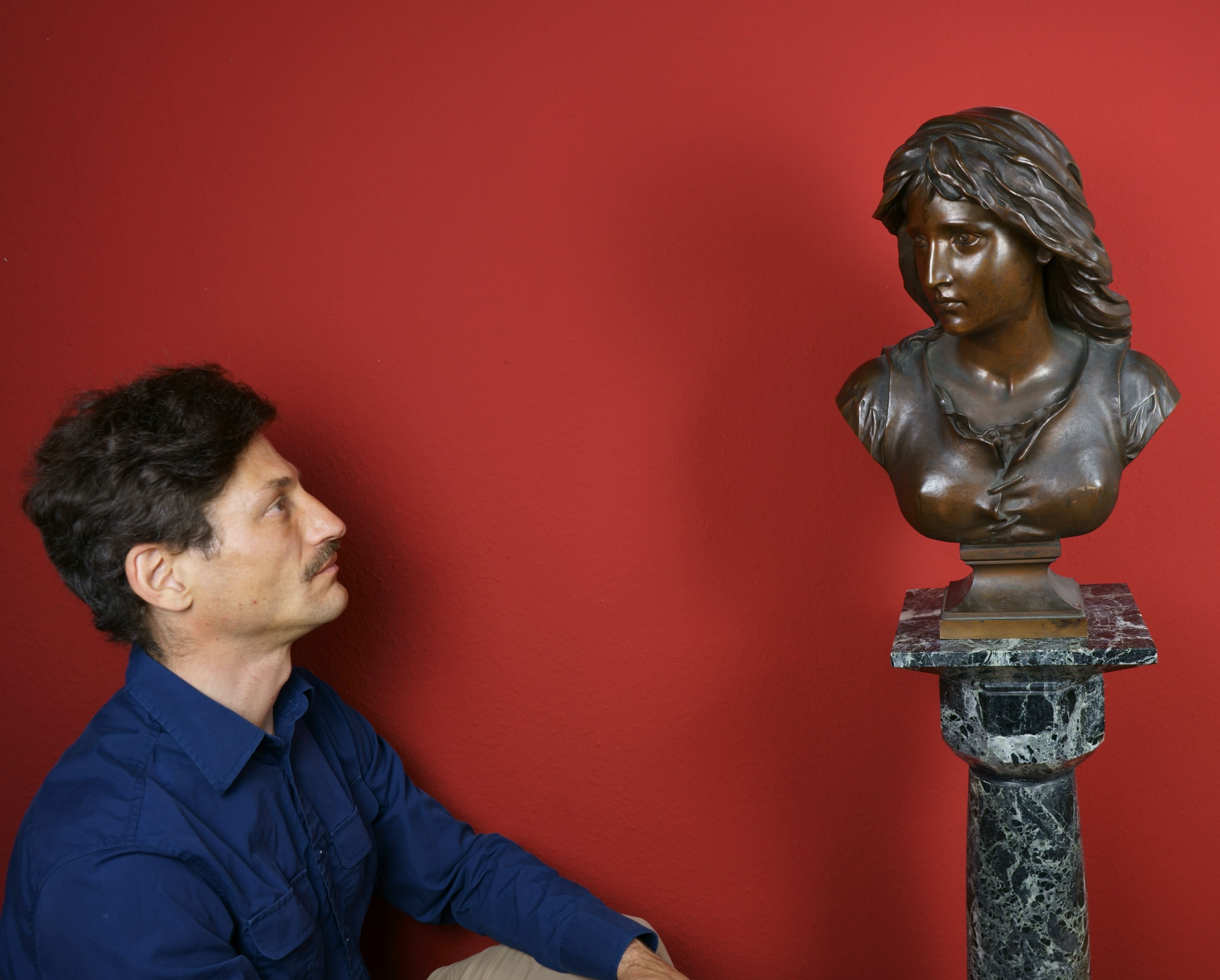
About the Seller
5.0
Vetted Professional Seller
Every seller passes strict standards for authenticity and reliability
Established in 2014
1stDibs seller since 2023
22 sales on 1stDibs
- ShippingRetrieving quote...Shipping from: Berlin, Germany
- Return Policy
More From This Seller
View AllField - Field research -
Located in Berlin, DE
Karl Ludwig Mordstein (1937 Füssen - 2006 Wilszhofen), Field 1983. Color etching, copy 13/65, 22.5 x 28 cm (image), 40 x 45 cm (sheet), 43 x 48 cm (frame), titled, numbered, monogram...
Category
1980s Abstract Abstract Prints
Materials
Etching
$422 Sale Price
20% Off
Untitled / - Association -
Located in Berlin, DE
Detlef Baltrock (*1954 Stuttgart), Untitled, 1985. Watercolor, 29.5 cm x 21 cm (visible dimensions), 41 cm x 32 cm (frame), signed “Baltrock” lower center and signed “[19]85”, label ...
Category
1980s Abstract Expressionist Abstract Drawings and Watercolors
Materials
Paper
$330 Sale Price
20% Off
Untitled / - The archaism of nature -
Located in Berlin, DE
Jorge Machold (1940 Chemnitz - 2015 Berlin), Untitled, 1973. Color etching, 41.5 x 29.2 cm (plate size), 49.5 cm x 39.5 cm (sheet size), signed lower right in lead “J.[orge] Machold”...
Category
1970s Abstract Abstract Prints
Materials
Paper
$206 Sale Price
20% Off
Indistinct Clear - Fluctuating ambivalence -
Located in Berlin, DE
Karl Ludwig Mordstein (1937 Füssen - 2006 Wilszhofen), Undeutlicher deutlich, 1982. Color etching, e.a. (Epreuve d'artiste) 4/9, 22.5 x 28 cm (image), 40 x 45 cm (sheet), 43 x 48 cm ...
Category
1980s Abstract Abstract Prints
Materials
Etching
$451 Sale Price
20% Off
Tectonic Tension / - Archetypes of Painting -
Located in Berlin, DE
Jürgen Möbius (*1939 Großenhain), Tectonic Tension. Oil on hardboard, 47.5 x 60 cm, 49 x 61.5 cm (frame), signed lower right "Möbius" and dated "[19]81".
- Upper left corner with a small chip, light scratches and a little rubbed in places. Provisional gallery frame with traces of use.
- Archetypes of Painting -
About the artwork
The form structure in front of the eye is overlapped by the frame. Thus, the frame does not open up a space in which something is presented, but rather shows the seemingly arbitrary section of a comprehensive context that cannot be framed as such.
We see forms that stand in a structure of tension with each other, whereby the individual black and brown forms, which continue almost endlessly beyond the frame, already show a tension in themselves, since they are not only forms, but also surfaces - form surfaces, while the light blue surface ground is at the same time forms that appear as surface forms. The formed surfaces and surface forms are nested within each other and form a structure that encompasses all elements.
The angular arrangement of the black and brown shaped surfaces gives the structure a tectonic character. The tension is thus heightened to the point of paradox, since the black shape at the front is overlapped by the brown shape at the bottom in the center of the picture, which would be impossible in real space. It is precisely through this "paradox" that Möbius demonstrates that the paradoxical is reality within painting. It is, so to speak, the most original possibility of painting, which distinguishes it from the other arts. In combination with the tectonic formations, Jürgen Möbius creates an archaic primordial painting, which, however, should not be confused with the autonomous color and form cosmos of Suprematism à la Kasimir Malevich. Instead of homogeneous, perfectly colored forms, here the colors are deliberately applied unevenly, and the light blue is mixed with the brown in a manner determined by the brushstroke. At the edges of the surface forms, the uneven application of paint allows the wood of the unprimed hardboard to show through. In this way, Möbius illustrates that we are dealing with a painting that has been created by an act of painting - an act, however, that takes hold of the original principles of painting and thus realizes painting as such.
About the artist
From 1959 to 1965 Jürgen Möbius studied painting at the University Institute for Art and Work Education in Mainz. He also studied philosophy and art history at the University of Mainz. Afterwards he worked as a freelance artist in Mainz.
At first, Möbius created material reliefs and installations, then, around 1974, he turned increasingly to conceptual art and added cinematic means. During this phase he wrote the manifesto-like essay "Principles of Supranatural Landscape" (1979).
From 1981 on, Möbius concentrated on painting and searched for artistic ways to "treat intellectual and sensual perception equally in the fusion of representational and abstract pictorial elements" (Wolfgang Zemter). He found inspiration on his study trips to Thailand and Sri Lanka.
"The pure painting of Jürgen Möbius flows through us as a timeless expression of memory and energy, ploughing our perception and bringing us the happiness of seeing authentic, immovable form.
- Philippe Büttner
Selection of solo exhibitions
1969 Galerie Würzner, Düsseldorf / Galerie Gurlitt, Mainz
1972 Städtische Galerie, Mainz
1973 Galerie Schloss Ringenberg Rathaus, Kleve
1974 Röderhausmuseum, Wuppertal
1976 Galerie Glasing, Osnabrück / Städtische Galerie, Herne
1977, 1997, 2004 Märkisches Museum, Witten
1979 Studio M, Bamberg / Staatstheater, Darmstadt
1980 Galerie Stolànovà, Wiesbaden / Mittelrheinmuseum, Koblenz
1982 Galerie Dornhöfer, Mainz
1984 Galerie Neumühle, Schlangenbad
1985 Landesmuseum, Mainz / Kunstverein, Ludwigshafen / Nassauischer Kunstverein, Wiesbaden
1986 Museum, Bochum / Galerie der Stadt Iserlohn
1987, 1990 Galerie Klaus Kiefer, Essen
1987, 2000 Galerie Ulrike Buschlinger, Wiesbaden
1988 Kunsthalle Darmstadt
1988, 1992, 1996, 1999 Galerie Leonhard, Basel
1992, 2002 Galerie Zulauf, Freisheim
1994 Galerie Remy, Vallendar
1995 Sendezentrum des Zweiten Deutschen Fernsehens, Mainz
2001 Collegium oecumenicum, Bamberg / MVB Forum für Kultur und Wirtschaft, Mainz
2006 Adam Gallery, London
Selection of group exhibitions
1969 ‘International Graphic Arts’, Galerie Dalléas Bordeaux, Paris
1975 ‘Deutscher Künstler-Bund’, Dortmund
1979 ‘Man and man’s Images’, Märkisches Museum Witten
1980 ‘Love-Dokuments of our Time’, Art Hall Darmstadt and Art Association Hannover
1982 ‘Work - Progress – Position’, Nassau Art Association Wiesbaden
1983 ‘Principle Hope – Utopic Aspects in Art and Culture of the 20th Century’, Museum Bochum
1986 ‘Selfportraits’, Gallery Klaus Kiefer Essen
1987 ‘The Dying and Death’, Gallery Klaus Kiefer Essen
1989 ‘Where are You, Revolution – Freedom, Liberty, Egality, Fraternity to-day’, Museum Bochum 1990 ‘Flight – a Problem within the Memory of Man’, Kunsthalle Darmstadt ‘Art and War 1939 – 89’, House of Cultures Berlin
1991 ‘Material and Form’, Pillnitz Castle Dresden and Pfalz Gallery Kaiserslautern
1995 20 Years Exhibitions, Chrämerhuus Langenthal, Schweiz
1998 ‘Works on Paper’, Klaus Kiefer Gallery Essen
2000 ‘Acquisitions 1900 – 2000’, Mittelrhein-Museum Koblenz
2001 ‘Strange Pictures’, Klaus Kiefer Gallery Essen
2002 ‘10 Years Buschlinger Gallery’, Buschlinger Gallery Wiesbaden
2004 ‘Eternal Space – Pictures and Sculptures’, Dome of Bamberg
2005 Art Fair Chicago, Adam Gallery, London
Selected Bibliography
Mittelrheinisches Landesmuseum (Hrsg.): Jürgen Möbius - Neue Bilder, Mainz 1985.
Kunstverein Darmstadt (Hrsg.): Jürgen Möbius. Bilder 1985 - 1988. Kunsthalle Darmstadt, 26. Juni - 14. August 1988. Red. Dorit Marhenke, Lyrik Marcus Schiltenwolf, Düsseldorf 1988.
Gabriele Prusko (Hrsg.): Jürgen Möbius. Mit Texten von Philippe Büttner und Ralph Mieritz, Basel 1992.
Wolfgang Zemter (Hrsg.): Jürgen Möbius - Aktuelle Arbeiten. Märkisches Museum der Stadt Witten, Bönen 1999.
Wolfgang Zemter (Hrsg.): Jürgen Möbius. Flieger in meinem Zimmer und Beruhigte Zone, Bönen 2004.
Dama Gallery...
Category
1980s Abstract Abstract Paintings
Materials
Oil
$1,315 Sale Price
20% Off
Figurative Composition / - Expressive Signs -
Located in Berlin, DE
Max Neumann (* 1949 Saarbrücken) and Eta Bender (*1948 Heidelberg), Figurative Composition, around 1970. Mixed media on tracing paper, mounted on thin backing paper, 29.6 cm x 21 cm,...
Category
1970s Abstract Expressionist Figurative Drawings and Watercolors
Materials
Paper
$519 Sale Price
20% Off
You May Also Like
7552 - Mixed Media by Renato Spagnoli - 1975
Located in Roma, IT
7552 is an artwork made by the Italian artist Renato Spagnoli (Livorno, 1928-Livorno, 2019) in 1975.
Mixed media
Hand signed, titled and dated on the back
Category
1970s Abstract Mixed Media
Materials
Mixed Media
7749 - Mixed Media by Renato Spagnoli - 1975
Located in Roma, IT
7749 is an artwork made by the Italian artist Renato Spagnoli (Livorno, 1928-Livorno, 2019) in 1974.
Mixed media.
Hand signed, titled and dated on the back.
Category
1970s Abstract Mixed Media
Materials
Mixed Media
7518 - Mixed Media by Renato Spagnoli - 1975
Located in Roma, IT
7518 is an artwork made by the Italian artist Renato Spagnoli (Livorno, 1928-Livorno, 2019) in 1974.
Mixed media.
Hand signed, titled and dated on the back.
Category
1970s Abstract Mixed Media
Materials
Mixed Media
Untitled, Abstract Minimalist Collage by Marilyn Whittmore
By Marilyn Whittmore
Located in Long Island City, NY
Artist: Marilyn Whittmore
Title: Untitled
Year: 1964
Medium: Collage, signed l.c. and verso
Size: 14 x 12 inches
Category
1960s Abstract Mixed Media
Materials
Mixed Media
7512 - Mixed Media by Renato Spagnoli - 1975
Located in Roma, IT
7512 is an artwork made by the Italian artist Renato Spagnoli (Livorno, 1928-Livorno, 2019) in 1974.
Mixed media
Hand signed, titled and dated on the back
Category
1970s Abstract Mixed Media
Materials
Mixed Media
Composition - Mixed Media by Roberto Crippa - Mid-20th century
By Roberto Crippa
Located in Roma, IT
Composition is an original contemporary artwork realized in the mid-20th century by Roberto Crippa.
Mixed media (tempera and collage).
Signature on the back.
Includes frame: 65 x 6 x 64 cm
Colorful and power artwork with a mixed composition of geometrical shapes and with different contrasting colors.
Gaetano Crippa known as Roberto Crippa (Monza, 1921 - Bresso, 1972) was an Italian painter, sculptor and aviator. He started painting in 1945, with a figurative style and cubist influence close to Picasso's style. He joined the spatial movement with Lucio Fontana, Gian Carozzi...
Category
Mid-20th Century Abstract Abstract Paintings
Materials
Mixed Media

